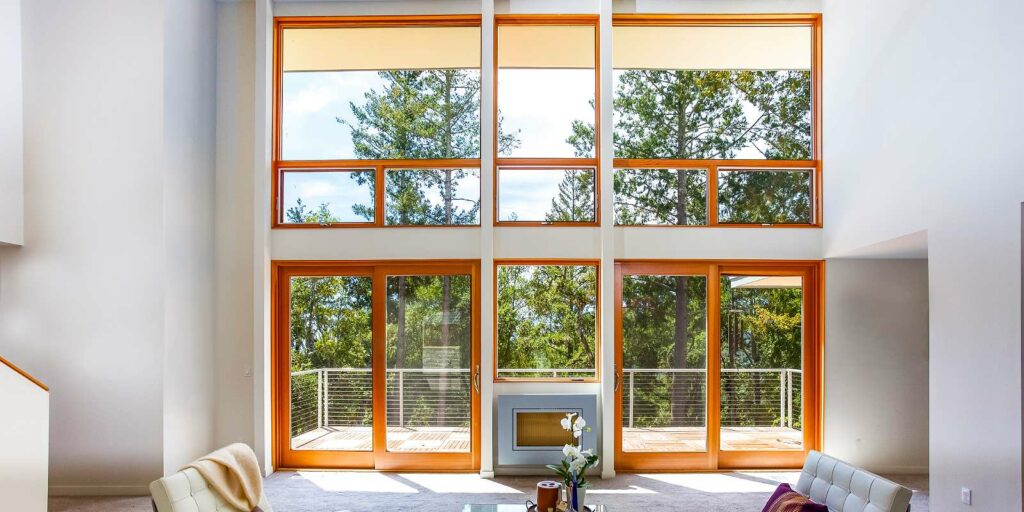While there are many aspects of glazing to consider from the standpoint of a building tenant, owner, or architect, the ones mentioned in energy regulations and standards are u-value (also known as u-factor) and solar heat gain coefficient (SHGC).
Consider the Following Glazing Technologies
- Gas Fills: Adding a gas fill to glazing assemblies with many panes improves the assembly’s thermal efficiency by providing more excellent resistance to heat flow over normal air, lowering the window’s u-value. The gases used are typically argon and krypton, which are inert (do not react readily with other elements). Although Argon is less expensive,Klarfonster.se has superior thermal properties.
- Heat-absorbing tints: These tints alter the colour of the glass to absorb a significant portion of the incoming solar energy, lowering SHGC, visual transmittance, and glare. However, some heat can still travel through the glass due to conduction and radiation. Therefore tinting does not reduce the u-value.
- Insulated glazing: Windows having two or more panes of glass are called insulated glazing (such as double-glazed or triple-glazed). The glass panes are separated individually and hermetically sealed together to create a separate section with a space gap, which helps to prevent heat transfer. Both the u-value and the SHGC are reduced as a result of this.
- Low-emissivity (Low-E) coatings: These coatings regulate heat flow through insulated glazing windows. On the surface of a glass pane, a microscopically thin metallic or metallic oxide layer is deposited. These coatings restrict infrared transmission from one glass to the next, lowering the window’s u-value (but reducing the visible transmittance). There are Low-E coatings for high, moderate, and low solar gain.
Reflective coatings are typically made up of thin metallic layers such as silver, gold, or bronze. The transmission of solar radiation is reduced by these coatings, which block more light than heat. As a result, apparent transmittance and glare are significantly reduced, whereas SHGC is lowered just a little.
Advances:
- When electricity is supplied to ‘active’ versions of intelligent windows, they can change from see-through to opaque. This type of glazing can eliminate the need for unsightly blinds, shades, or even curtains, and it also blocks UV rays when unclear. The window’s colour can also be changed to block out heat and light. The ‘passive’ variants do not require an electrical input and adjust their light transmission qualities in response to environmental temperature changes.
Solar power generators are number two. Why not windows? Roof slates may now double as electricity generators (though not for a complete home), so why not windows? These do exist, but they are not yet entirely transparent. A Klarfonster.se, however, has installed photovoltaic (PV) collectors along the window’s outer edge, allowing for a standard see-through window within. PV glass blocks are also making their appearance.
- Spectrally selective coatings, considered the next stage in low-e technology, filter away 40 to 70% of the heat ordinarily conveyed through the transparent glass while allowing the entire amount of light to pass through. Customizing what gets filtered out enables the coatings to be tailored to local climatic circumstances.
- The technology of phase change. These windows combat overheating by physically absorbing and storing heat from the sun throughout the day, releasing it as the internal temperature drops at night. This is accomplished using a salt that melts at high temperatures and recrystallizes at lower temperatures.
Benefits:
- It keeps the view.
– Blinds and shade devices are not required with Dynamic Glass.
- It improves security.
– Because the employs laminated glass as part of the glass make-up, it will not shatter, and even if the glass is broken, the interlayer will continue to operate and tint the window.
- It conserves energy.
– This saves energy by lowering heating and cooling demands in the winter and summer, respectively. This could lead to energy savings.
- Noise reduction
– The Dynamic Glass dampens noise. This is especially useful for buildings near highways and airports.
- Moderation of glare
– The sun-responsive technology in the Dynamic Glass eliminates extra light and reduces glare, making it easier for users to use their electronic devices.
How does energy-saving triple glazing work?
Triple glazing increases the amount of heat trapped in your home. Low-E glass does an excellent job of reflecting heat into your home and preventing it from escaping. As a result, your home will take less time and money to heat because less heat will run through the windows, saving you money!
Conclusion: Smart, self-tinted window glazing brings the future to reality. This technology enables superior climate control and considerably increased energy efficiency for single and double glass window systems, whether installed in residential or commercial structures. Noise reduction and glare moderation are also advantages of this thermo chromic dynamic glass technology, resulting in more expansive perspectives.
